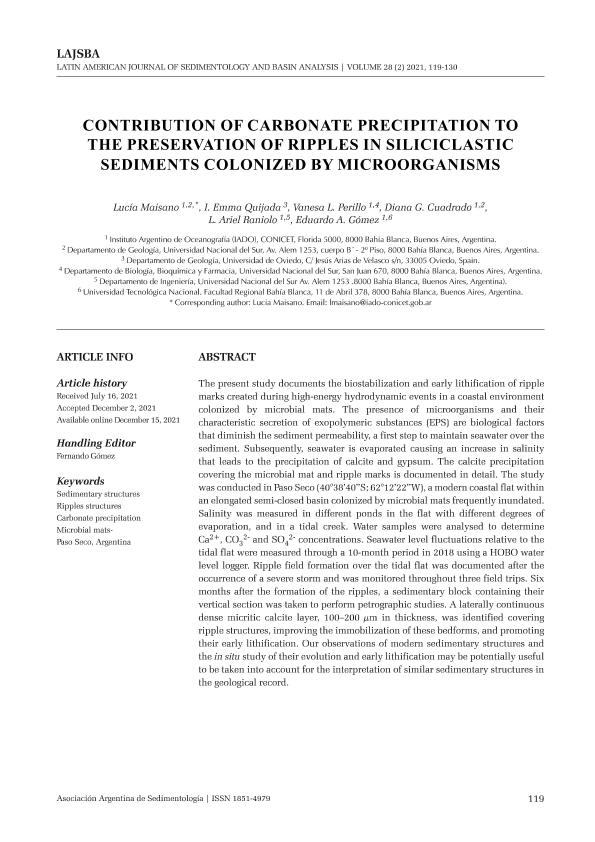Mostrar el registro sencillo del ítem
dc.contributor.author
Maisano, Lucia

dc.contributor.author
Quijada, Isabel Emma

dc.contributor.author
Perillo, Vanesa Liliana

dc.contributor.author
Cuadrado, Diana Graciela

dc.contributor.author
Raniolo, Luis Ariel

dc.contributor.author
Gomez, Eduardo Alberto

dc.date.available
2022-05-05T20:19:16Z
dc.date.issued
2021-12-15
dc.identifier.citation
Maisano, Lucia; Quijada, Isabel Emma; Perillo, Vanesa Liliana; Cuadrado, Diana Graciela; Raniolo, Luis Ariel; et al.; Contribution of carbonate precipitation to the preservation of ripples in siliciclastic sediments colonized by microorganisms; Asociación Argentina de Sedimentología; Latin American Journal of Sedimentology and Basin Analysis; 28; 2; 15-12-2021; 119-130
dc.identifier.issn
1669-7316
dc.identifier.uri
http://hdl.handle.net/11336/156691
dc.description.abstract
The present study documents the biostabilization and early lithification of ripple marks created during high-energy hydrodynamic events in a coastal environment colonized by microbial mats. The presence of microorganisms and their characteristic secretion of exopolymeric substances (EPS) are biological factors that diminish the sediment permeability, a first step to maintain seawater over the sediment. Subsequently, seawater is evaporated causing an increase in salinity that leads to the precipitation of calcite and gypsum. The calcite precipitation covering the microbial mat and ripple marks is documented in detail. The study was conducted in Paso Seco (40°38’40’’S; 62°12’22’’W), a modern coastal flat within an elongated semi-closed basin colonized by microbial mats frequently inundated. Salinity was measured in different ponds in the flat with different degrees of evaporation, and in a tidal creek. Water samples were analysed to determine Ca2+, CO3 2- and SO4 2- concentrations. Seawater level fluctuations relative to the tidal flat were measured through a 10-month period in 2018 using a HOBO water level logger. Ripple field formation over the tidal flat was documented after the occurrence of a severe storm and was monitored throughout three field trips. Six months after the formation of the ripples, a sedimentary block containing their vertical section was taken to perform petrographic studies. A laterally continuous dense micritic calcite layer, 100–200 µm in thickness, was identified covering ripple structures, improving the immobilization of these bedforms, and promoting their early lithification. Our observations of modern sedimentary structures and the in situ study of their evolution and early lithification may be potentially useful to be taken into account for the interpretation of similar sedimentary structures in the geological record.
dc.format
application/pdf
dc.language.iso
eng
dc.publisher
Asociación Argentina de Sedimentología
dc.rights
info:eu-repo/semantics/openAccess
dc.rights.uri
https://creativecommons.org/licenses/by-nc/2.5/ar/
dc.subject
SEDIMENTARY STRUCTURES
dc.subject
RIPPLE STRUCTURES
dc.subject
CARBONATE PRECIPITATION
dc.subject
MICROBIAL MATS
dc.subject.classification
Oceanografía, Hidrología, Recursos Hídricos

dc.subject.classification
Ciencias de la Tierra y relacionadas con el Medio Ambiente

dc.subject.classification
CIENCIAS NATURALES Y EXACTAS

dc.title
Contribution of carbonate precipitation to the preservation of ripples in siliciclastic sediments colonized by microorganisms
dc.type
info:eu-repo/semantics/article
dc.type
info:ar-repo/semantics/artículo
dc.type
info:eu-repo/semantics/publishedVersion
dc.date.updated
2022-04-21T17:10:39Z
dc.identifier.eissn
1851-4979
dc.journal.volume
28
dc.journal.number
2
dc.journal.pagination
119-130
dc.journal.pais
Argentina

dc.journal.ciudad
La Plata
dc.description.fil
Fil: Maisano, Lucia. Consejo Nacional de Investigaciones Científicas y Técnicas. Centro Científico Tecnológico Conicet - Bahía Blanca. Instituto Argentino de Oceanografía. Universidad Nacional del Sur. Instituto Argentino de Oceanografía; Argentina. Universidad Nacional del Sur. Departamento de Geología; Argentina
dc.description.fil
Fil: Quijada, Isabel Emma. Universidad de Oviedo; España
dc.description.fil
Fil: Perillo, Vanesa Liliana. Consejo Nacional de Investigaciones Científicas y Técnicas. Centro Científico Tecnológico Conicet - Bahía Blanca. Instituto Argentino de Oceanografía. Universidad Nacional del Sur. Instituto Argentino de Oceanografía; Argentina. Universidad Nacional del Sur. Departamento de Biología, Bioquímica y Farmacia; Argentina
dc.description.fil
Fil: Cuadrado, Diana Graciela. Consejo Nacional de Investigaciones Científicas y Técnicas. Centro Científico Tecnológico Conicet - Bahía Blanca. Instituto Argentino de Oceanografía. Universidad Nacional del Sur. Instituto Argentino de Oceanografía; Argentina. Universidad Nacional del Sur. Departamento de Geología; Argentina
dc.description.fil
Fil: Raniolo, Luis Ariel. Consejo Nacional de Investigaciones Científicas y Técnicas. Centro Científico Tecnológico Conicet - Bahía Blanca. Instituto Argentino de Oceanografía. Universidad Nacional del Sur. Instituto Argentino de Oceanografía; Argentina. Universidad Nacional del Sur. Departamento de Ingeniería; Argentina
dc.description.fil
Fil: Gomez, Eduardo Alberto. Consejo Nacional de Investigaciones Científicas y Técnicas. Centro Científico Tecnológico Conicet - Bahía Blanca. Instituto Argentino de Oceanografía. Universidad Nacional del Sur. Instituto Argentino de Oceanografía; Argentina. Universidad Tecnológica Nacional. Facultad Regional Bahía Blanca; Argentina
dc.journal.title
Latin American Journal of Sedimentology and Basin Analysis
dc.relation.alternativeid
info:eu-repo/semantics/altIdentifier/url/https://lajsba.sedimentologia.org.ar/index.php/lajsba/article/view/28-2-3/
Archivos asociados
